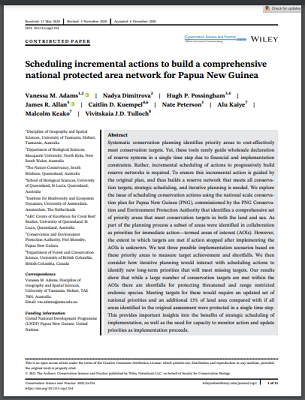
Systematic conservation planning identifies priority areas to cost-effectively meet conservation targets. Yet, these tools rarely guide wholesale declaration of reserve systems in a single time step due to financial and implementation constraints. Rather, incremental scheduling of actions to progressively build reserve networks is required. To ensure this incremental action is guided by the original plan, and thus builds a reserve network that meets all conservation targets, strategic scheduling, and iterative planning is needed. We explore the issue of scheduling conservation actions using the national scale conservation plan for Papua New Guinea (PNG), commissioned by the PNG Conservation and Environment Protection Authority that identifies a comprehensive set of priority areas that meet conservation targets in both the land and sea. As part of the planning process a subset of areas were identified in collaboration as priorities for immediate action—termed areas of interest (AOIs). However, the extent to which targets are met if action stopped after implementing the AOIs is unknown. We test three possible implementation scenarios based on these priority areas to measure target achievement and shortfalls. We then consider how iterative planning would interact with scheduling actions to identify new long-term priorities that will meet missing targets. Our results show that while a large number of conservation targets are met within the AOIs there are shortfalls for protecting threatened and range restricted endemic species. Meeting targets for these would require an updated set of national priorities and an additional 13% of land area compared with if all areas identified in the original assessment were protected in a single time step. This provides important insights into the benefits of strategic scheduling of implementation, as well as the need for capacity to monitor action and update priorities as implementation proceed.












